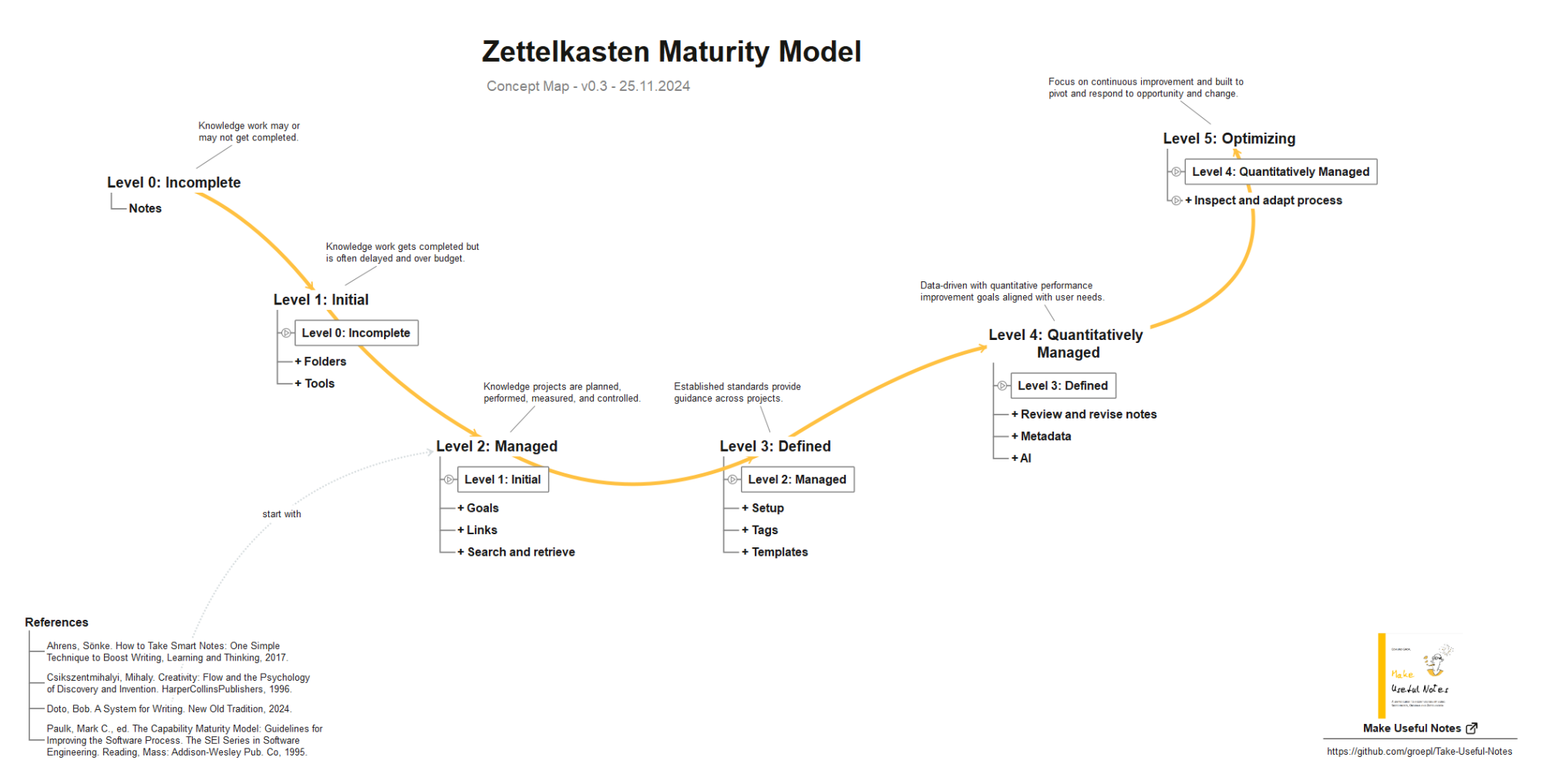Zettelkasten Evolution - A Maturity Model

A maturity model [1] can be viewed as a set of structured levels that describe how well the behaviors, practices, and processes of an organizational system can reliably and sustainably deliver the required results. While originally designed for software development, its structured approach to improvement can inspire creativity when applied to other areas of life.
Imagine training for a marathon. At first, you might struggle to run even a single mile (Level 0: Incomplete). But as you keep practicing, you manage short, inconsistent runs (Level 1: Initial). With time and effort, you create a basic training plan, running regularly each week (Level 2: Managed). Over time, you refine your routine, tailoring your runs to build speed and endurance (Level 3: Defined). Eventually, you monitor your progress with stats and tweak your plan for specific goals like improving pace (Level 4: Qualitatively Managed). Finally, running becomes second nature, and you experiment with new techniques to keep improving (Level 5: Optimizing).
This same concept of structured growth is the foundation of maturity models. But what happens when we apply it to personal knowledge systems like the Zettelkasten [2]? Drawing on Csikszentmihalyi’s insights into creativity [3], this playful application can reveal new ways to think about the evolution of our own note-taking systems. The enclosed concept map explores six levels of Zettelkasten maturity:
- Level 0: Incomplete
- Level 1: Initial
- Level 2: Managed
- Level 3: Defined
- Level 4: Qualitatively Managed
- Level 5: Optimizing
My questions: Where is my Zettelkasten on this map? Will this framework inspire fresh insights into my system? And how can it guide the evolutionary development of my knowledge organization?
References
[1] Paulk, Mark C., ed. The Capability Maturity Model: Guidelines for Improving the Software Process. The SEI Series in Software Engineering. Reading, Mass: Addison-Wesley Pub. Co, 1995.
[2] Ahrens, Sönke. How to Take Smart Notes: One Simple Technique to Boost Writing, Learning and Thinking, 2022.
[3] Csikszentmihalyi, Mihaly. Creativity: Flow and the Psychology of Discovery and Invention. HarperCollinsPublishers, 1996.
Edmund Gröpl
100% organic thinking. Less than 5% AI-generated ideas.
Howdy, Stranger!

Comments
Zettelkasten Maturity Model - A Point Note Map
The "Zettelkasten Maturity Model" is my first "Point Note". It is based on four "Source notes":
It's a new way of thinking for me. My "Permanent Notes" are other people's ideas written down in my own words. "Point Notes" now are my own ideas based on the ideas of others. And that makes a difference. As Allosso said in his book: "Point Notes I can use to further develop a train of thought that will lead to output.” - p.23
My learning: It's never to late to read a second book. ;-)
Reference
Allosso, Dan. How to Make Notes and Write. Kindle, 2022
Edmund Gröpl
100% organic thinking. Less than 5% AI-generated ideas.
I do understand the distinction between citing a source and writing down one's own ideas.
But I am still very surprised that e.g. you @Edmund with more than a couple days of practice jump onto the train of separating your notes by type. I did that in the early days, too; it was part of my ZK's conception in 2009 -- but that didn't last any test of time. So while I do sympathize with starting with that idea, I'm terribly confused why implementing it into an already existing body of notes seems to draw people in Would enjoy reading you explanations, or rationalizations, or wild guesses eventually.
Would enjoy reading you explanations, or rationalizations, or wild guesses eventually.
Author at Zettelkasten.de • https://christiantietze.de/
@Edmund is it SimpleMind you create all your mindmaps in? How do you store and search them afterwards?
@ctietze
i think we always have categories, structure notes is a category, daily note, to-develop note, outdated note etc. Categories add more access point/links and context without limiting other access options, also may contribute to your sanity. But they should be made bottom-up, from chaos.
Thank you @ctietze for sharing your experience. Here is my motivation to start with "Point Notes" from in an established Zettelkasten. Two "hidden concepts" may help to explain:
Categories
I do not separate my notes by type. My idea is to define categories by type to build up groups of notes with similar characteristics. e.g. #type\concept, #type\example, #type\insight, #type\method, #type\observation, #type\pattern, #type\point ... These notes are not separated, they are connected by type. All notes are in one folder named 3_Permanent Notes. It's a folder without any subfolders.
Richard Feynman’s 12 Problems
In my Zettelkasten there is a note about "Richard Feynman’s 12 problems". It was published by Gian-Carlo Rota in 1979.
The concept of point notes is a "new trick" for me. "How to improve my Zettelkasten" is one of my 12 problems. To see if "Point Notes" can help, it will take up to 12 weeks for some experiments.
And I'll share my results with you.
Edmund Gröpl
100% organic thinking. Less than 5% AI-generated ideas.
Yes, it is SimpleMind.
How do I store my visuals? In my Obsidian vault I have two separate folders. (1) links to the PNG file within the "Visuals" folder, (2) to the SMMX file with the SimpleMind source in the "Visuals/SimpleMind" subfolder. Each time when I create a new version of the SMMX file, I save an export as PNG without changing the initial filename.
To re-find my visuals I have to search for my Permanent Notes with all the keywords, links and tags they contain.
Yes, I can fully agree with that.
Edmund Gröpl
100% organic thinking. Less than 5% AI-generated ideas.